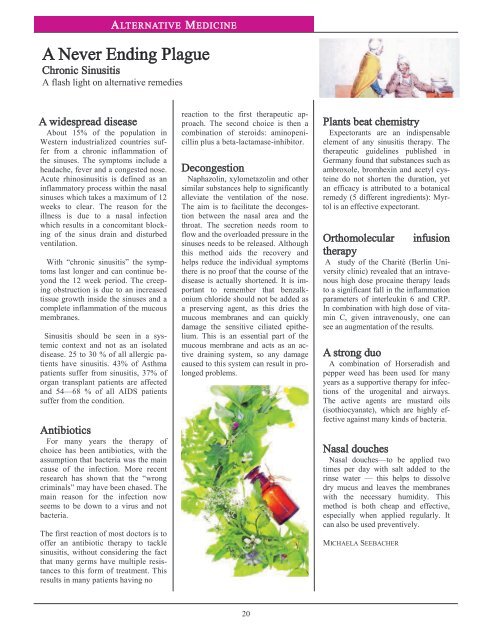Thepatients_prot
You also want an ePaper? Increase the reach of your titles
YUMPU automatically turns print PDFs into web optimized ePapers that Google loves.
ALTERNATIVE MEDICINE<br />
A Never Ending Plague<br />
Chronic Sinusitis<br />
A flash light on alternative remedies<br />
A widespread disease<br />
About 15% of the population in<br />
Western industrialized countries suffer<br />
from a chronic inflammation of<br />
the sinuses. The symptoms include a<br />
headache, fever and a congested nose.<br />
Acute rhinosinusitis is defined as an<br />
inflammatory process within the nasal<br />
sinuses which takes a maximum of 12<br />
weeks to clear. The reason for the<br />
illness is due to a nasal infection<br />
which results in a concomitant blocking<br />
of the sinus drain and disturbed<br />
ventilation.<br />
With “chronic sinusitis” the symptoms<br />
last longer and can continue beyond<br />
the 12 week period. The creeping<br />
obstruction is due to an increased<br />
tissue growth inside the sinuses and a<br />
complete inflammation of the mucous<br />
membranes.<br />
Sinusitis should be seen in a systemic<br />
context and not as an isolated<br />
disease. 25 to 30 % of all allergic patients<br />
have sinusitis. 43% of Asthma<br />
patients suffer from sinusitis, 37% of<br />
organ transplant patients are affected<br />
and 54—68 % of all AIDS patients<br />
suffer from the condition.<br />
Antibiotics<br />
For many years the therapy of<br />
choice has been antibiotics, with the<br />
assumption that bacteria was the main<br />
cause of the infection. More recent<br />
research has shown that the “wrong<br />
criminals” may have been chased. The<br />
main reason for the infection now<br />
seems to be down to a virus and not<br />
bacteria.<br />
The first reaction of most doctors is to<br />
offer an antibiotic therapy to tackle<br />
sinusitis, without considering the fact<br />
that many germs have multiple resistances<br />
to this form of treatment. This<br />
results in many patients having no<br />
reaction to the first therapeutic approach.<br />
The second choice is then a<br />
combination of steroids: aminopenicillin<br />
plus a beta-lactamase-inhibitor.<br />
Decongestion<br />
Naphazolin, xylometazolin and other<br />
similar substances help to significantly<br />
alleviate the ventilation of the nose.<br />
The aim is to facilitate the decongestion<br />
between the nasal area and the<br />
throat. The secretion needs room to<br />
flow and the overloaded pressure in the<br />
sinuses needs to be released. Although<br />
this method aids the recovery and<br />
helps reduce the individual symptoms<br />
there is no proof that the course of the<br />
disease is actually shortened. It is important<br />
to remember that benzalkonium<br />
chloride should not be added as<br />
a preserving agent, as this dries the<br />
mucous membranes and can quickly<br />
damage the sensitive ciliated epithelium.<br />
This is an essential part of the<br />
mucous membrane and acts as an active<br />
draining system, so any damage<br />
caused to this system can result in prolonged<br />
problems.<br />
Plants beat chemistry<br />
Expectorants are an indispensable<br />
element of any sinusitis therapy. The<br />
therapeutic guidelines published in<br />
Germany found that substances such as<br />
ambroxole, bromhexin and acetyl cysteine<br />
do not shorten the duration, yet<br />
an efficacy is attributed to a botanical<br />
remedy (5 different ingredients): Myrtol<br />
is an effective expectorant.<br />
Orthomolecular<br />
infusion<br />
therapy<br />
A study of the Charité (Berlin University<br />
clinic) revealed that an intravenous<br />
high dose procaine therapy leads<br />
to a significant fall in the inflammation<br />
parameters of interleukin 6 and CRP.<br />
In combination with high dose of vitamin<br />
C, given intravenously, one can<br />
see an augmentation of the results.<br />
A strong duo<br />
A combination of Horseradish and<br />
pepper weed has been used for many<br />
years as a supportive therapy for infections<br />
of the urogenital and airways.<br />
The active agents are mustard oils<br />
(isothiocyanate), which are highly effective<br />
against many kinds of bacteria.<br />
Nasal douches<br />
Nasal douches—to be applied two<br />
times per day with salt added to the<br />
rinse water — this helps to dissolve<br />
dry mucus and leaves the membranes<br />
with the necessary humidity. This<br />
method is both cheap and effective,<br />
especially when applied regularly. It<br />
can also be used preventively.<br />
MICHAELA SEEBACHER<br />
20


